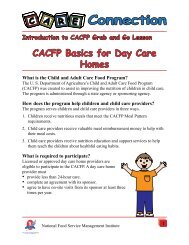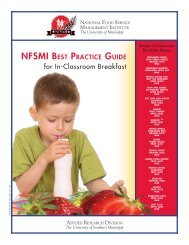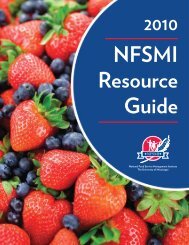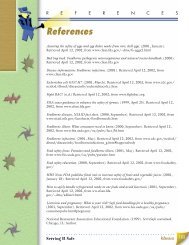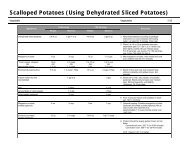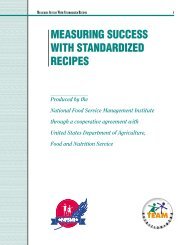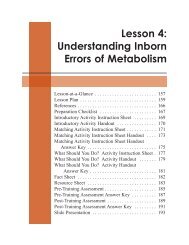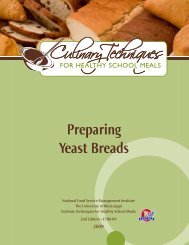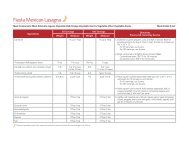financial management information system - National Food Service ...
financial management information system - National Food Service ...
financial management information system - National Food Service ...
You also want an ePaper? Increase the reach of your titles
YUMPU automatically turns print PDFs into web optimized ePapers that Google loves.
F INANCIAL A NALYSIS AND P ROGRAM E VALUATION S ECTION 4administrator can determine a per meal cost and productivity ratios such as meals per labor hour. Meal costs based on mealequivalents allow school foodservice administrators to better benchmark <strong>financial</strong> performance, both internally andexternally. Examples of meal equivalent conversion formulas and calculations are presented below.LunchAll student reimbursable lunches and full-paid adult lunches are counted as one meal equivalent for each lunch served. If astudent purchases more than one lunch on a given day, the second lunch is considered non-reimbursable and is reported aseither an extra food sale or adult meal sale. The category for reporting is determined by state agency requirements. Luncheseaten by school foodservice employees at no charge for the meal are considered “inkind” meals and should not be countedas a meal equivalent.BreakfastThe method used in this document for determining breakfast meal equivalents specifies that three breakfasts are theequivalent of two lunches. In 2004, this breakfast meal equivalency was updated from a ratio in which two breakfast wereconsidered the equivalent of one lunch. The new ratio is based on recommendations from participants in a national taskforce convened to update the Financial Management Information System model. It is important to note that the mealequivalent ratio used for calculating breakfast meal equivalents varies from state to state. For this reason, school foodserviceadministrators should check with their state agencies for guidance. Once a ratio is selected it should remain consistent forthe entire reporting period (year) for comparisons or benchmarking in order to be meaningful.Using the FMIS formula, breakfast meal equivalents are calculated as follows:Meal Equivalent = Number Breakfasts Served x conversion factor (2÷3 = .66)Example: A school foodservice program served 300 student reimbursable breakfasts and 58 adult breakfasts on a givenday. Using the formula that 3 breakfasts are equivalent to 2 lunches, the breakfasts served were equivalent to 236lunches or meal equivalents.358 x .66= 236.28 or 236Afterschool SnacksNSLP snacks are served to children and youth in afterschool care programs that are eligible for USDA reimbursement.While there are no current research studies to support the meal equivalency ratio, a survey of selected state agenciesindicated most states use a 3-to-1 ratio of snacks to lunch. Using this equivalency, snacks can be converted to mealequivalents as follows:Meal Equivalent = Number of Snacks Served3Example: An elementary school served 450 students reimbursable afterschool snacks. Using the formula that 3 snacksare equivalent to 1 meal, the snacks served to students on this particular day were equivalent to 150 lunches or mealequivalents.4503= 15065N ATIONAL F OOD S ERVICE M ANAGEMENT I NSTITUTE



